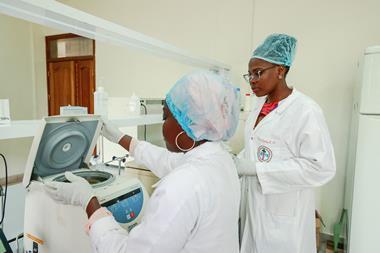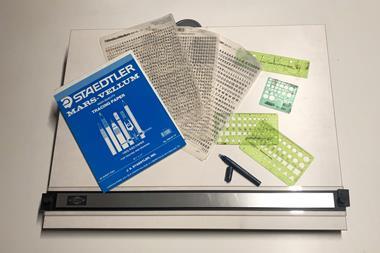Periodic tables, relevant research and undergraduate cheating.
Carbon captures
David Jones’s ‘Last Retort’ highlighted the adsorptive properties of some types of carbon, which has led me to postulate on their role in photography.
In 1855, finely dispersed carbon in gelatine was sensitised to light following exposure to potassium dichromate under strong sunlight. Negatives made from this could be contact printed onto conventional silver bromide paper. Developments continued into the 20th century, evolving into the three-colour ‘carbro’ process. In one manifestation, the colours were derived from three pigments rather than dyestuffs. Exact details are hard to come by but it seems that three identical sensitised carbon–gelatine plates, each having its own colour filter, were simultaneously exposed. Following some unexplained chemistry, the final colour pigments were lead chromate (yellow), ferric ferrocyanide (blue) and nickel glyoxime (red).
It may be that the exposed plates were washed with aqueous solutions of the appropriate cations, which were adsorbed on the carbon and later converted to their insoluble pigments by washing with aqueous solutions of the appropriate anions. While I have not been able to find any written evidence for this, what is certain is that the three gelatines were removed from their plates and had to be overlaid manually.
The colours of such prints are remarkably stable and true to life. A keen exponent of this technique was Percy Hennell who had been head of the photographic department of the Metal Box Company. Hennell produced over 1000 prints using his special three plate camera, which has been preserved by the Science Museum.
M Humphrey MRSC
Hertfordshire, UK
Table for 118
In his article ‘The elemental treasure hunt’, Jamie Gallagher introduces a new version of the periodic table of the elements, celebrating the country of discovery of each element, with the UK taking pride of place with 23 elements (and the ancients not doing too badly with 12.5). This adds yet another to the myriad forms of the periodic table. Many of these are listed in the ‘periodic table of periodic tables’, which provides links to an extensive, and eclectic set. (An amusing recent version is the London underground map of the elements.) Apple’s App Store currently lists 171 periodic table apps, of which a most impressive (and free) version is The elements: a visual exploration.
The periodic table takes many forms, but has also been appropriated as an organising principle in many other situations, such as in typography, music and even the longevity of condiments. A comprehensive list can be found in Mark Leach’s extensive and current ‘internet database of periodic tables’.
Leslie Glasser
Curtin University, Australia
Ed: The RSC’s visual elements periodic table contains a wealth of elemental information, including Chemistry World’s Chemistry in its element podcasts. Readers may also be interested in our feature on the periodic table.
Burning question
On reading the letter ‘And into the fire’ by Mark Foreman, discussing antimony fire retardants, I recalled a highly interesting perspective on their use which I read in a grant application over 30 years ago. The senior investigator made the point that the stage at which to prevent a fire is ignition, not subsequent propagation. With reference to antimony retardants, he questioned why a slowly moving highly toxic flame should be less hazardous than a more rapidly moving much less toxic one. I am unaware of whether this question has been addressed.
J C Jones FRSC
University of Aberdeen, UK
Research relevance
Having read the article ‘What’s the use?’ by Derek Lowe, I was pulled up short straight away. Turning the page we have researchers looking for elements 113–118 and then later an article about the colour of dinosaurs.
How is this going to save the planet, improve food production, or discover more diagnostic tests and new pharmacology to treat humans? Will such research contribute to providing sufficient low carbon energy? Will those who are starving and dying from consumption of dirty water really benefit from knowing what colour a dinosaur was? Why are millions of pounds being spent on finding element 115 when cancer research charities beg for money?
In the past, I suspect researchers have engaged their minds in finding solutions to problems humans face on a day to day basis. Can we return to this type of research and avoid speculative activity that only a few people might like to know about? Other articles in the issue cover research that is on course to do this and are applauded.
M French MRSC
Welling, UK
Your cheating heart
The mention of cheating in science has made me think. Most cases where people get caught involve results that are unexpected. It makes me wonder how many instances of cheating turn in the expected result and so are not questioned. Ultimately, the level of cheating is going to be unknown.
I remember some incidents from undergraduate teaching. There was a practical course at one university that consisted of a suite of experiments that students had to complete in a term. One experiment caused students a lot of trouble and some spent hours trying to get it to work. Investigation revealed the apparatus had been assembled incorrectly and was unworkable. Curiously, some students’ experiments were still successful.
In the same university it was the custom for third year students to undertake a research project under the supervision of a postgraduate. A typical project could be commissioning a new piece of apparatus and, in several cases, students returned results with apparatus later found to be very difficult or impossible to use.
Of course if cheating undergraduates move away from science after graduation, the harm is limited. However if they go into research then there might be many more fictitious results.
W Edwards CChem CSci FRSC
Essex, UK
Science inhibited
I sympathise with David Snodin’s comments in his letter ‘A call to toxicology’, regarding the need for chemists to be involved with toxicology. Only a holistic study can reveal the toxicology of substances, requiring a close partnership between pathologists, mammalian toxicologists, formulation and analytical chemists and metabolic chemists. During a career of 30 years, I saw many examples where adoption of that approach was able to avoid potential problems with new products. It is a cause of great concern to me that regulatory box ticking and outsourcing toxicology can result in products going to market without a real understanding of their toxicology.
In my opinion, one major factor which tends to hinder a full understanding of a substance is the need to stick rigidly to a protocol for a toxicology study. In the past, it was normal for professionals to use their investigative skills freely without the fear of jeopardising the validity of a study. I experienced several examples where serendipitous observations by chemists had a major influence on the future of a compound. Today things are much more constrained, with regulations stifling initiative. Regulation has its place, but not where it inhibits science.
M K Baldwin FRSC
Kent, UK












No comments yet